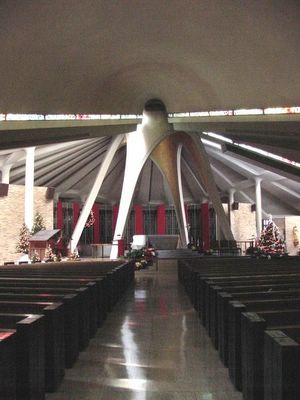More demolition in New Orleans
I don't normally write about post-1960 buildings, other than to describe their faults. Mark Folse and others in New Orleans are fighting the imminent demolition of the St. Frances Cabrini Church in the Gentilly neighborhood, built in 1963, and quite majestic.
 Photo by Mark Folse.
Photo by Mark Folse.Check out this blog entry "The Cathedral of the Lakefront." From the entry:
A landmark piece of modern architecture in a city that usually celebrates its historic roots, St. Frances Xavier Cabrini Church in the Gentilly section of New Orleans is facing imminent demolition under circumstances Tulane University architecture professor Steve Verdeber and some parishioners suggest are suspicious.
At a meeting in Cabrini's windswept parking lot on Nov. 11, just outside the red ribbons that marked a keep out zone where workers removed asbestos from the building in preparation for demolition, the architect and others questioned the manner in which the Archdiocese of New Orleans and Holy Cross School obtained the rights to demolish the property. Holy Cross plans to build a new campus at the Gentilly site to replace their flood damaged Ninth Ward home.
According to parishioners, a meeting held earlier this year to discuss the churches fate had no agenda listing potential transfer of the church, which is owned building and property by the parish, to the archdiocese for demolition. Several people who attended the parish meeting left before the issue was raised and a vote was taken, unaware that the question was even scheduled. They said the meeting did not represent the wishes of the majority of parishioners.
The Pittsburgh History and Landmarks Foundation signed an agreement with the Archdiocese of Pittsburgh to do preservation planning with regard to churches there. It's a pathbreaking agreement. For the most part, church organizations tend to prefer to make land use decisions without regard to the collective good.
(I am agnostic, but I like church architecture, especially stained glass windows.)
For some of my other writings about the role of churches in neighborhood stabilization and destabilization, see:
-- Losing my religion: Shiloh Baptist Church and Neighborhood Destabilization
-- More about churches
-- Religion and politics and neighborhood improvement
-- Faith based profits.
For more on demolition in New Orleans, check out Squandered Heritage.
Index Keywords: urban-revitalization



0 Comments:
Post a Comment
<< Home